 The Lookout
The LookoutIs the poverty rate even higher than thought?

In September, Americans accustomed to dismal economic news absorbed another rude blow, with reports that a record 46.2 million Americans were living in poverty, and that the poverty rate had jumped in recent years. But the actual rate may in fact be even higher than that--while the recent spike may be less severe than thought, a new study is expected to show.
On Monday, the U.S. Census Bureau will release a report that uses an alternative--and many say a more accurate--method of measuring poverty. Unlike the conventional method, which is largely unchanged since it was created in 1963, the new one will count tax credits and non-cash benefits--food stamps, for instance--as income. The new calculus will also include medical costs--an enormous fixed expense for some Americans, especially seniors. The Census Bureau's revised method of assessing poverty will also take into account the vastly different costs of living across the country.
How will that change things? According to the New York Times, experts expect the new measure to show that the share of Americans living in poverty is actually slightly higher than the 15.1 percent--already very high by historical standards--the Census researchers reported in September.
But the Census Bureau's new findings may also show that the Great Recession and the halting recovery that has followed didn't have as big an impact as September's report suggested. That study found that since 2006, the number of Americans living in poverty has risen by a whopping 9.7 million. The Times reports that a study published last week using alternate Census data showed a gain of less than half that figure--4.6 million. The more recent study also showed that 39 states experienced no significant growth in poverty during that period. That study was similar in methodology to the government's new analysis out Monday.
In addition, because the new Census report will include medical costs as a fixed expense, it will likely show a higher poverty rate among seniors, though a lower one among children.
One other takeaway from the alternate measure, which could have political implications as lawmakers haggle over budget cuts: Safety net programs such as food stamps and tax credits appear to have played a major role in keeping many Americans' heads above water.
Supporters of such programs are already using that projected finding to argue against cuts to such programs. The new measure "is showing that government help is keeping millions of families above the poverty line right now," Arloc Sherman of the liberal Center on Budget and Policy Priorities told the Times.
Opponents may counter, in turn, that because the programs are already sizable--combined, food stamps and tax credits accounted for $221 billion in spending last year, almost all benefiting low income people--they can afford to be trimmed.
Want more of our best national affairs stories? Visit The Lookout or connect with us on Facebook and follow us on Twitter.
Other popular Yahoo! News stories:
• The Boy Scouts: Preparing young men for the music festivals of tomorrow
• Herman Cain mulling suit against Politico for harassment story

